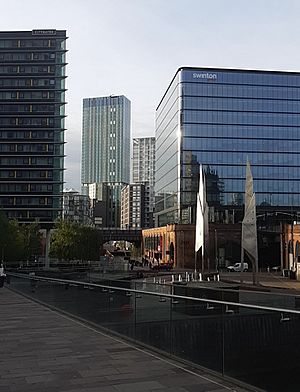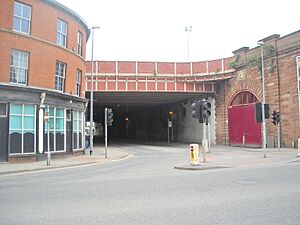Greengate, Salford facts for kids
Quick facts for kids Greengate, Salford |
|
|---|---|
 |
|
| OS grid reference | SJ833986 |
| Metropolitan borough | |
| Metropolitan county | |
| Region | |
| Country | England |
| Sovereign state | United Kingdom |
| Post town | SALFORD |
| Postcode district | M3 |
| Dialling code | 0161 |
| Police | Greater Manchester |
| Fire | Greater Manchester |
| Ambulance | North West |
| EU Parliament | North West England |
Greengate is a historic area in Salford, Greater Manchester, England. It sits right next to the River Irwell and is very close to the City of Manchester. Greengate is known as the oldest part of Salford. It is currently seeing lots of new buildings and growth because of its great location.
Contents
History
Salford's Ancient Heart
Greengate was the oldest and most important part of the medieval town of Salford. It was the main center for law and military decisions for a large area, much like today's Greater Manchester. The town market and yearly fairs were held at the Salford Cross, right on Greengate. You can still find the spot where the marketplace was, where Greengate meets Gravel Lane. This area also had a courthouse, stocks (for punishment), and a water pump.
Salford Bridge and Early Life
The Salford Bridge was built over the River Irwell in the 1300s, connecting Salford to Manchester. In 1642, a battle happened at this bridge during the English Civil War. Forces from Salford who supported the King were stopped by Parliament's forces from Manchester. Even before the Industrial Revolution, Greengate was known for making and dyeing fabrics.
By the early 1800s, Greengate became very crowded. Many people lived in small, packed homes, and there were also factories. From 1793 to 1853, Salford's workhouse, a place where poor people could live and work, was located here.
The Bible Christian Church
In 1800, a clergyman named William Cowherd started a new church in Greengate on King Street. He built the chapel, called Christ Church, himself. This church led to the creation of the Bible Christian Church. This group became very important in starting the modern vegetarianism movement. Cowherd taught that people should "eat no more meat till the world endeth" and also avoid alcohol. In 1817, 41 members of his church traveled across the Atlantic to spread this message in the U.S. Cowherd was buried in the churchyard.
Collier Street Public Baths
The Collier Street Public Baths opened in 1855. They were named after Samuel Francis Collier, a Methodist Minister. These public baths offered places for people to bathe and also to wash and dry clothes. Many workers' homes at the time did not have good washing facilities. This was common until after World War I. The Baths closed in 1880 when Salford Corporation opened new baths nearby. The men's pool was larger and more fancy than the ladies' pool. The Baths closed in the early 1900s and later became a matchbox factory. During World War II, an air raid shelter was built in the deep end of the ladies' pool.
St Peter's Church
The Roman Catholic church of St Peter was built in 1863. It was designed by E. W. Pugin in a simple Gothic revival style. It was taken down in 1983.
Greengate Today
In the 21st century, Greengate has been greatly improved. The old Victoria Bus Station, which is across the Irwell from Manchester Cathedral, has been redeveloped. This area now includes Greengate Square, which has a special outdoor theater for events, concerts, and markets. There are also new offices, hotels, and shops in the area.




